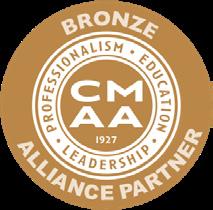CLUB ROAD
What’s Inside?


CHAMBERS ISSUE N O 12 • WINTER 2016
A Chambers Publication Useful but Unexpected Resources for GMs p.2 Building a Knockout Board Orientation Program p.6 Embracing Clubs Within a Club p.7 Perception is Everything: Defining Brand p.7 PLUS Behind the Curtain with Rick Christensen, VP of our new Minneapolis office!
THE A
AGAINST
Friends —
It has been a little while since we’ve last seen each other. These days life goes by a mile a minute, and sometimes it seems as though everyone and everything is competing for your attention all at once.
It is with this thought in mind that we decided to dedicate this latest issue of Club Road to the subject of time – or lack thereof. Going forward, clubs are going to have to provide the most value possible to prove that they are worthy of their members’ limited time.
It may seem like a daunting prospect, but even the smallest changes can create value and have your members flocking to the club when they can spare a moment. Here, we discuss some of the ways to make that happen.
How does your club offer value to its members? Get in touch and let us know! We look forward to hearing from you.
Regards,

USEFUL BUT UNEXPECTED RESOURCES
for General Managers
General managers have a lot to juggle on a daily basis. It’s just part of the job description. But even the greatest leaders didn’t make history acting alone, and the same rule applies to club management.
There are plenty of resources you can use to make your club the best it can be, but some are more obvious than others. Take a peek at some of the most underutilized resources in the club management world!
VISIT OUR BLOG >>
NATIONAL RESTAURANT ASSOCIATION


 Rick Snellinger Bob Hickman
President & CEO Chairman of the Board
Rick Snellinger Bob Hickman
President & CEO Chairman of the Board
 Email Rick Email Bob
Email Rick Email Bob
From food quality to staff retention, a club’s Food & Beverage Department presents numerous challenges for GM’s. Yet it’s more important now than ever to have club dining functioning optimally to compete with local restaurants. The National Restaurant Association offers a wealth of resources that can help clubs get on par with standalone restaurants, including information on the latest food trends, best hiring practices, tips on maintaining equipment, and much more.

FEATURED A NOTE FROM CHAMBERS CLUB ROUNDUP
CHAMBERSUSA .COM 2 ]
CHAMBERS IS PROUD TO BE A CMAA CAP SPONSOR.
Whether you are looking for a helping hand or trying to stay ahead of the curve, these unique resources can help!
CONNECT: BALTIMORE / DALLAS / MINNEAPOLIS
MITCH STUMP
Affectionately known as “the club tax guy,” Mitch Stump offers first-rate consulting services pertaining to private club accounting. With over 35 years of tax experience, Stump offers a treasure trove of industry-specific information that can save GM’s time and money when Uncle Sam comes a-knockin’ in April. His free monthly newsletter is brimming with valuable information on what to do (and what not to do) when it comes to club finances.

PROFESSIONAL WEB CONTENT MANAGERS

It’s certainly no secret that having a web presence is a big deal in today’s world, but building a website that best represents your club certainly isn’t easy. Rather than just hiring a friend-of-a-friend that can code, seek out a professional web content manager that can build a robust site tailored to your club’s specific needs, maintain the website as needed, and write polished content that will represent your club in the best light.
ETS CORPORATION

Technology is becoming more and more intertwined with the daily functions of private clubs, making the need for airtight security greater than ever. ETS has created a comprehensive package especially for CMAA members that increases the efficiency and security of billing systems, helping to make the process a little easier for clubs. This package not only streamlines billing for clubs, but also simplifies the payment process for members and improves their overall experience. s
PRIVATE CLUB FILMS

If you’ve been searching for an effective way to create a distinct online presence for your club, then consider showcasing your club’s finest features through a professional video created by Private Club Films Marketers project that video will make up 79% of internet traffic in 2018. That’s only 2 years away! It’s not only a smart investment for membership retention and recruitment, but it will also help you get ahead of the curve – so why not hire a company that specializes in private clubs? Having a quality video on your website will put you ahead of other clubs, as well as local restaurants, bars, and other establishments that are competing for your members’ time. Source: www.privateclubfilms.com

FEATURED GET IN TOUCH! CLUBROAD@CHAMBERSUSA.COM / 410.727.4535 CLUB ROAD Issue No 12 / Winter 2016 CLUB ROAD is a Chambers publication. Managing Editor: Lauren Gordon clubroad@chambersusa.com 410.727.4535 2 5 Unexpected Resources for General Managers 4 A Race Against the Clock Competing for Member Time 6 Building a Knockout Board Orientation 7 Embracing Clubs Within a Club + What’s in a Brand? Part I 8 Behind the Curtain with Rick Christensen, AIA BALTIMORE / DALLAS / MINNEAPOLIS PLANNING • ARCHITECTURE INTERIOR DESIGN • PURCHASING CHAMBERSUSA .COM 1899 CLUB ROAD
AGAINST THE A Race
CHALLENGE:
PARENTS WANT TO INCLUDE THEIR CHILDREN IN THEIR ACTIVITIES


What is the biggest challenge that clubs face today in terms of increasing member retention and recruitment? Time.
Today, a typical private club member has a wide array of family, friends, work, and social activities constantly vying for their attention. With members enjoying more ways to spend their days than ever before, proving that their club is worth their time – and their dues – is becoming increasingly challenging. To recruit and retain members, clubs must realize that the way members view and use their club is changing. And if you’re going to win a member’s time, it is important to recognize the amenities, services, and practices that bolster membership value. We’ve compiled a list of the primary challenges that clubs face when it comes to competing for member time and how to win the battle!

CHALLENGE:
PEOPLE ARE SEARCHING FOR A TRANQUIL ESCAPE

READ THE FULL STORY OI N OUR BLOG CHAMBERSUSA
4 ]
.COM
FEATURED
CHALLENGE: MEMBERS ARE EMBRACING AN ACTIVE LIFESTYLE



There’s no doubt about it: fit is the new it. People are becoming increasingly more health-conscious. Private athletic clubs and fitness studios offering group exercise classes are a favorite way to pass the time for all ages. Even retirees are embracing a more active lifestyle, abandoning the traditional dream of languishing beneath palm trees in favor of rugged activities like hiking and biking. If members wish to pursue a healthy, active lifestyle that clubs can’t accommodate, they’ll soon be spending their precious time in an establishment that is better aligned with their goals.
In today’s world, parents hope to include their children in their activities, or at least provide them with an exciting experience. But clubs have historically been a place where children were better seen than heard – if seen at all, that is. This means that for members with kids, clubs consistently get last priority among more family-friendly options. The only way to attract and keep the attention of young families and parents is by engaging their children and taking their needs into consideration.
CHALLENGE: LOCAL RESTAURANTS ENCROACHING ON CLUB TERRITORY
With most chain restaurants adopting trend-driven menus and offering family-friendly environments, it’s easy for members to stray away from their club in favor of other establishments. Now more than ever, it’s important for clubs to pull members to their dining facilities – and make sure those dining facilities strike a proper balance. A focus on dining is also essential for attracting younger members who are eating out more often than any other generation before them. While club dining isn’t (and never will be) the restaurant experience, it can –and should – give traditional restaurants a run for their money.
We all know that these days everything moves a mile a minute. Between work, emails, phone calls, text messages, and endless social media notifications, it sometimes feels as though we can’t even take a breath without enduring someone else’s expectations. During their down time, members want to relax without worrying about the pressures and formalities of day-to-day life. Unfortunately, many clubs are seen as bastions of formality, leading some members to spend their free time elsewhere.

CLUBROAD@CHAMBERSUSA.COM [ 5
CLICK TO SEE THE SOLUTION CLICK TO SEE THE SOLUTION CLICK TO SEE THE SOLUTION CLICK TO SEE THE SOLUTION
LET’S GIVE THEM A WARM (and helpful) WELCOME!
BUILDING A KNOCKOUT BOARD ORIENTATION PROGRAM
Considering that the Board determines the future of your club in a multitude of ways, it is important to get each and every Board Member started on the right foot. Creating a thoughtful orientation program can make the difference between a productive Board Member and a frustrated (or apathetic) Board Member. An excellent Orientation should leave a new Board Member feeling secure in their position and excited to begin forging a bright future for the club! Of course, this is easier said than done. Let’s take a peak at the essential components...
Step 1: Create an Optimal Learning Environment
It’s no secret that our surroundings can make a huge difference for learning comprehension. With this in mind, it’s critical to create the ideal environment for properly and effectively orienting your new Board Members.

First, it is important for new Board Members to know how much time and dedication is expected of them upfront. “Laying out expectations for the orientation in advance lets them carve out time in their schedules and understand how in-depth the orientation is going to be. It’s important to work with their schedules, but they also need to know that the Orientation is not just a 15-minute process,” says Michael Stott, General Manager of the Baltimore Country Club.
Secondly, it is important to consider the location of the orientation. Some clubs choose to host their orientation in a relaxing environment away from the club, such as an upscale restaurant or hotel. This allows the General Manager and Board to truly welcome new Board Members with open arms and avoid interruptions from Club staff. Unfortunately, holding an off-site orientation sacrifices the opportunity to give your new Board Members a back-of-house tour, or show them club facilities that they probably haven’t explored as regular members. But we’ll discuss why an understanding of club operation is so important later!
There is also the question of group size. Though most clubs only elect
a few Board Members at a time, it’s important to consider whether you want to orient them individually or in a group. Orienting new Board Members independently allows each new recruit to enjoy individualized attention and ask a wide variety of questions. Orienting everyone in one fell swoop saves time, but risks sacrificing quality in the process. Ultimately, the number of Members you orient at once will depend on your need to conserve time and your ability to communicate effectively. Choose the option that works best for you and your club!
DOWN TO BUSINESS CHAMBERSUSA .COM 6 ]
CLICK TO VISIT OUR BLOG & READ THE REST!
Bunny or duck?

PERCEPTION IS EVERYTHING

PART I: DEFINING BRAND


Identifying what sets your club apart

The word “brand” gets thrown around a lot these days. Whether you’re discussing a company’s brand, your favorite brand, your personal brand – the buzz around branding seems never-ending. Chambers is no exception to this rule. We drive home the importance of branding because it is an essential component for club prosperity and plays a surprisingly large part in planning for a club’s future. After all, a well-defined brand provides a guiding light for every decision you and your Board will make. Even more importantly, it allows you to develop a reason for your members to continue returning to the club year after year.
This two-part series will dive into the fundamentals of successfully recognizing and executing your club’s brand.
In part one, we will explore the numerous ways to pinpoint what your club does best. Though many clubs have already established a kind of “brand” that is deeply rooted in their storied histories, further defining this brand provides a distinct guideline for future decisions. It can also reveal when a club should consider revamping an outdated brand and adapt to an ever-changing market.
Defining a club brand is a tricky process, partly because many clubs can’t establish their brands in the same way that businesses do. “A club brand is usually loftier than a company brand because they don’t have a lot of external communications or advertising in the traditional sense. It is more about how the club is viewed by the marketplace and prospective members,” says John Snellinger, Chambers’ Vice President and Director of Planning. When it comes to clubs, their brand, culture, and perceptions intertwine so seamlessly that it can be difficult to tell them apart. READ MORE >>
EMBRACING “CLUBS WITHIN A CLUB”


How interest-based clubs can enhance the member experience

In today’s hectic world, private clubs are always striving to provide greater value to their members. The social realm of the club must extend beyond the lush green of the golf course and into the interests of diverse memberships. Building a social environment that caters to the individual interests of each and every member not only allows them to enjoy their passions, but also bond over common hobbies.
When it comes to establishing a “club within a club,” the possibilities are endless. Before putting effort into creating one (or more), it is important to fully understand what your members love and what kind of clubs would spark their interests. Though each private club has its own unique membership that is passionate about different things, there are some “clubs within a club” that regularly pass the membership test with flying colors…
CLUBROAD@CHAMBERSUSA.COM [ 7 CLUB EXPERIENCE
CLICK TO READ MORE! WINE SOCIETY
INVESTMENT
BOOK CLUB TRAVEL CLUB DANCE CLUB
CLUB BRIDGE CLUB
RICK CHRISTENSEN, AIA Vice President


CR: When did you first start working with private clubs?

RC: The very first club that I designed was in 1986 – the Municipal Clubhouse in St. Paul, Minnesota.The clubhouse was in a prominent city park that had a really cool pavilion building – almost like a conservatory (pictured above). We followed the architecture of that structure and created a really beautiful clubhouse. After that project I didn’t design anything in the club industry for about 4 years, until I joined a new firm that decided to go into the field. Aside from a few projects, I have only worked private clubs from 1989 until today.

As you may have heard, Chambers has recently opened an office in Minneapolis headed by the company’s new Vice President and long-time architect Rick Christensen. With over two decades of experience working almost exclusively with private clubs, it’s fair to say that Rick is an expert in the field. Here he shares his beginnings, as well as some of the wisdom he has accumulated throughout many years of hard work and dedication to his craft.
CR: What do you love most about working with clubs?
RC: I love golf. It’s one of my favorite ways to spend my free time, so my affinity for working with clubs partially ties in with that. I also just enjoy working with people and committees. You are taking a diverse group of people and creating something together, which is pretty incredible. It is just fun to get everyone excited about a new project and then actually see it executed. READ MORE >>
CR: In your opinion, what is the most beneficial renovation that a club can make?
RC: It all comes down to the center of the club. Today, it is the casual place where everyone – adults, kids, families – can sit and enjoy a meal together. It’s important to create an environment that’s more like a restaurant and less like the traditional “stuffy” country club. This has really been a mission for me since the 90’s. READ MORE >>
BEHIND THE CURTAIN
rick christensen is always thinking about the next big thing
CLICK TO READ THE FULL INTERVIEW GET IN TOUCH WITH RICK! rchristensen@chambersusa.com
CONNECT: BALTIMORE / DALLAS / MINNEAPOLIS
Como Park Conservatory in St. Paul, MN






 Rick Snellinger Bob Hickman
President & CEO Chairman of the Board
Rick Snellinger Bob Hickman
President & CEO Chairman of the Board
 Email Rick Email Bob
Email Rick Email Bob
























